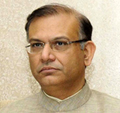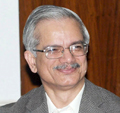INDIAN ARMED FORCES CHIEFS ON OUR RELENTLESS AND FOCUSED PUBLISHING EFFORTS

SP Guide Publications puts forth a well compiled articulation of issues, pursuits and accomplishments of the Indian Army, over the years

"Over the past 60 years, the growth of SP Guide Publications has mirrored the rising stature of Indian Navy. Its well-researched and informative magazines on Defence and Aerospace sector have served to shape an educated opinion of our military personnel, policy makers and the public alike. I wish SP's Publication team continued success, fair winds and following seas in all future endeavour!"

Since, its inception in 1964, SP Guide Publications has consistently demonstrated commitment to high-quality journalism in the aerospace and defence sectors, earning a well-deserved reputation as Asia's largest media house in this domain. I wish SP Guide Publications continued success in its pursuit of excellence.
'Udan' Launched

The Indian civil aviation landscape is in the process of major transformation and the Ministry of Civil Aviation took another giant leap towards that – by launching the Regional Connectivity Scheme (RCS) under the name of ‘UDAN’ which means flight. UDAN seeks to get more people to fly from smaller towns and cities, from un-served and under-served areas to the metros, connecting India like never before.
Launching ‘UDAN’, the Minister of Civil Aviation, Ashok Gajapathy Raju said ‘We will target the first flights under ‘UDAN’ to take off by January 2017.” The crux of the scheme’ is to make flying accessible and affordable to the vast majority of people living in the hinterland. ‘UDAN’ (flight) is also an acronym in Hindi ‘Ude Desh ka Aam Nagrik’ (the common man of the country will fly).
UDAN is an acronym for Ude Desh Ka Aam Naagrik which means “enabling average Indian fly”.
Echoing this view, the Minister of State, Jayant Sinha said the scheme is ‘to get those wearing hawai chappals on to an aircraft. We have tried to make costs of flying lower to serve underserved and other routes.” ‘UDAN’ is said to be the first of its kind globally wherein it would jumpstart the regional aviation segment in India. “We are very hopeful of a positive response from the industry but our thinking is that with the scheme, we will in fact be jump-starting regional aviation,” Sinha said while exuding confidence that the scheme would be “quite attractive” for consumers, carriers, small and regional airlines, lessors and other players in the ecosystem. The government would create a new category of scheduled commuter operators to enable people to enter and get started in the regional space, he added.

The Civil Aviation Minister tweeted “Growth rates in civil aviation encouraging; intend to keep the momentum.” RCS is one of the key elements of NCAP 2016, which envisions domestic ticketing of 30 crores by 2022 and 50 crores by 2027. RCS as well as NCAP 2016 would eventually promote growth of the entire civil aviation sector.
The objectives, he said, were to
- Affordability – take flying to the masses
- Connectivity – revive more than 50 underserved and unserved airports in small and medium cities
- Growth – to promote tourism, encourage balanced growth and increase employment opportunities in the hinterland
“We will target the first flights under ‘UDAN’ to take off by January 2017.”
— Ashok Gajapathy Raju, Minister of Civil Aviation
The Civil Aviation Secretary RN Choubey said that it was unfortunate that in a country of 1.3 billion people domestic ticketing stands at 80 million. “We hope to have flights to 50 more airports in the next four years through the Regional Connectivity Scheme. Under the scheme, airlines will have complete freedom to enter into code sharing with larger airlines for connectivity.” Also, regional connectivity flights will be exempted from various airport charges. Airlines will get exclusive rights for 3 years to fly on a particular regional route. Airfares will be capped at Rs. 2,500 for an hour’s flight for regional flights under the scheme. “We want to make sure entry and exit barriers are kept reasonably low. Airline can withdraw from scheme after 1 year,” the Aviation Secretary said.
“We are very hopeful of a positive response from the industry but our thinking is that with the scheme, we will in fact be jump-starting regional aviation”
— Jayant Sinha, Minister of State
Viability gap funding
Choubey said viability gap funding will be provided to airlines for 3 years under the UDAN scheme. The bidding for airlines to get subsidy under the scheme will take place twice a year beginning today. The government has appointed MSTC Limited to carry out reverse auction (airlines asking for lowest subsidy amount wins). “We don’t agree with airlines’ opposition to put a levy on them to fund the scheme,” according to Choubey. The new levy on airlines will be announced by October 31, he added. VGF will be provided for RCS Flights for a period of three years from the date of commencement of operations of such RCS Flights (Tenure of VGF Support).
It may be recalled that earlier this year the Ministry of Civil Aviation had released the National Civil Aviation Policy 2016 (NCAP 2016). One of the objectives of NCAP 2016 is to “enhance regional connectivity through fiscal support and infrastructure development”.
As per an ICAO study - “Economic benefits of civil aviation: ripples of prosperity”, the output and employment multipliers of aviation are 3.25 and 6.10 respectively. This implies that every 100 Rupees spent on air transport contributes to 325 Rupees worth of benefits, and every 100 direct jobs in air transport result in 610 jobs in the economy as a whole. In fact, the study attributes over 4.5% of the global Gross Domestic Product (GDP) to civil air transport.
“We hope to have flights to 50 more airports in the next four years through the Regional Connectivity Scheme. Under the scheme, airlines will have complete freedom to enter into code sharing with larger airlines for connectivity”
“We want to make sure entry and exit barriers are kept reasonably low. Airline can withdraw from scheme after 1 year”
— RN Choubey, Secretary, Ministry of Civil Aviation
As the Indian economy grows, consumption-led growth in populated metros is expected to spill over to hinterland areas. This is also expected to be on account of factors of production (land, labor, etc.) becoming costlier in the densely populated metro cities. In this scenario, air connectivity can provide required impetus to the economic growth of regional centers (towns / cities). In this context, one of the key objectives of NCAP 2016 is to “establish an integrated eco-system which will lead to significant growth of civil aviation sector, which in turn would promote tourism, increase employment and lead to a balanced regional growth”.
Scheme objective
The primary objective of RCS is to facilitate / stimulate regional air connectivity by making it affordable. Promoting affordability of regional air connectivity is envisioned under RCS by supporting airline operators through (1) concessions by Central Government, State Governments (reference deemed to include Union Territories as well, unless explicitly specified otherwise) and airport operators to reduce the cost of airline operations on regional routes / other support measures and (2) financial (viability gap funding or VGF) support to meet the gap, if any, between the cost of airline operations and expected revenues on such routes.
State Government concessions
The State Governments’ buy-in and support to determine eligibility: To minimise the cost of operations for air transport operators to the extent possible through concessions from State governments.
Operational only in States which support
RCS is accordingly to be made operational only in States and at airports/helipads (irrespective of ownership by AAI / State Governments / private entities / Ministry of Defence, Government of India) which demonstrate their commitment and support to regional air transport operations by providing concessions / support as required under the Scheme.
The RCS has listed out the concessions / support that need to be offered by the respective State Governments at RCS Airports within their States:
- Reduction of VAT to 1% or less on ATF at RCS Airports located within the State for a period of ten (10) years from the date of notification of this Scheme. Upon transition to GST, rates will be applicable as determined under GST and exemptions/ concessions shall be given as permissible so that such a reduced level of taxation could ideally be continued.
- Coordinating with oil marketing companies for provision of fueling infrastructure on best effort basis.
- Provision of minimum land, if required, free of cost and free from all encumbrances for development of RCS Airports and also provide multi-modal hinterland connectivity (road, rail, metro, waterways, etc.) as required;
- Provision of security and fire services free of cost at RCS Airports through appropriately trained personnel and appropriate equipment as per applicable standards and guidelines by relevant agencies;
- Provision of, directly or through appropriate means, electricity, water and other utility services at substantially concessional rates at RCS Airports;
- Provision of a certain share (20%) towards VGF for respective RCS Routes (pertaining to the State), provided the share of States in the North-Eastern region of India and Union Territories would be (10%).
Concessions to offered by the airport operators:
- Airport operators (whether under the ownership of the AAI, State Governments, private entities or the Ministry of Defence, Government of India) shall not levy Landing Charges and Parking Charges or any other charge subsuming a charge for such aspects in future on RCS Flights.
- Selected Airline Operators shall be allowed to undertake ground handling for their RCS Flights at all airports.
- AAI shall not levy any Terminal Navigation Landing Charges (TNLC) on RCS Flights.
- Route Navigation and Facilitation Charges (RNFC) will be levied by AAI on a discounted basis @ 42.50% of Normal Rates on RCS Flights. Normal Rates refer to applicable rates specified by the AAI on its website from time to time without any discounts or concessions.
As provided for in NCAP 2016, air freighter operations at RCS Airports shall be entitled to the following under the Scheme for a period of up to 10 years from the date of notification of this Scheme. The Excise Duty at the rate of 2% shall be levied on ATF drawn for air freighter operations at RCS Airports for a period of three (3) years from the date of notification of this Scheme. Upon transition to GST, rates will be applicable as determined under GST and exemptions/ concessions shall be given as Page 12 of 46 permissible so that such a reduced level of taxation could ideally be continued. There are other concessions too but VGF support shall not be provided for cargo operations.
Airfare Cap under RCS
Airfare Cap to be considered for respective stage lengths / flight duration are as follows:
For Fixed Wing Aircraft
| Stage length (in km) | Airfare cap per RCS seat in Rs |
| 151-175 | 1420 |
| 176-200 | 1500 |
| 201-225 | 1580 |
| 226-250 | 1670 |
| 251-275 | 1750 |
| 276-300 | 1830 |
| 301-325 | 1920 |
| 326-350 | 2000 |
| 351-375 | 2080 |
| 376-400 | 2170 |
| 401-425 | 2250 |
| 426-450 | 2330 |
| 451-475 | 2420 |
| 476-500 | 2500 |
| 501-525 | 2500 |
| 526-550 | 2590 |
| 551-575 | 2680 |
| 576-600 | 2770 |
| 601-625 | 2860 |
| 626-650 | 2950 |
| 651-675 | 3050 |
| 676-700 | 3140 |
| 701-725 | 3230 |
| 726-750 | 3320 |
| 751-775 | 3410 |
| 775-800 | 3500 |
| > 800 | 3500 |
For Helicopters
| FLIGHT DURATION (IN MINUTES) | AIRFARE CAP PER RCS SEAT (INR) |
| 00-30 | 2,500 |
| 31-35 | 2,900 |
| 36-40 | 3,350 |
| 41-45 | 3,750 |
| 46-50 | 4,150 |
| 51-55 | 4,600 |
| 56-60 | 5,000 |








